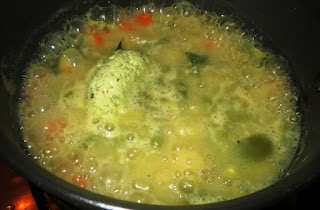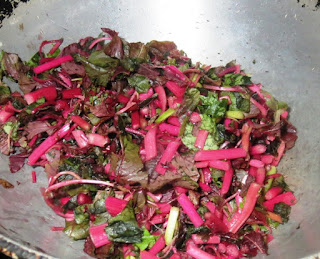 |
| Ready to Serve Avalakki Bisibele Baat |
Bisibele baath is a full meal dish and it does contain rice, dal, vegetables and spices normally. Bisi means hot, bele is dal and baath is some rice dish. It is well known dish of Karnataka. People just love this dish and prepare using peas or legumes according to the season and the available vegetables or pulses. Bisible baat is anytime favourite dish of many. They do prepare for breakfast, lunch or dinner. It is easy to pack it for office goers or traveling.As I said earlier bisibele baath contain a whole lot of vegetables, dal and rice, the person will not feel hungry for a long time. It does contain loads of minerals, vitamins and carbohydrates. It gives loads of energy.
Here in this recipe of " Avalakki Bisi Bele Baat ", and I have used Awalakki (beaten rice of flattened rice or poha or awal) instead of rice. Some how I do not feel comfortable eating rice in the morning. Avalakki is always light and healthy. There is a little twist in preparing bisibele baat here. Vegetables, dal, Mango chutney (instead of coconut and tamarind) and bisibele baath powder are used. Mango chutney adds to the taste. .
Let us see some benefits of having dals and legumes or lentils and Avalakki (Poha) in our diet.
Beans or peas or legumes are natural source of protein. They are high in fiber, low in fat and easy to digest. They are also rich in vitamins (A, B, C and E). They contain calcium, iron and potassium. They are rich source of dietary fiber. They help to control blood sugar levels, ease digestion and control high cholesterol.Avalakki or Poha is packed with iron and eating poha regularly can prevent iron deficiency of anemia. They are good source of Carbohydrates. They are needed to help our body, store energy and perform various other functions. Intake of carbohydrates from healthy source is vital and Avalakki is one of the healthy source. They are good for diabetes. They are also low in gluten.
Avalakki Bisi Bele Baath do not contain any onions or garlic, and we can prepare this dish for any festival or feast, special days or fasting time. It also can be ideal for kitty parties or get together parties.
Things Needed:
To Cook :
Thick Avalakki (Flattened rice or Poha): 2 CupsToor Dal : 3/4 Cup.
Peas : 1 Cup
Carrots : 2
Capsicum " 1
Spice :
Bisibele baath powder: 2 to 3 Table spoonsMango chutney : 1 Small cup
Salt : according to the taste
Seasoning :
Mustard Seeds : 1 Tea spoonUrid dal : 1 Tea spoon
Oil : 2 Table spoons
Ghee : 1 Table spoon
Ingh (Asafoetida): a pinch
Curry leaves : One handful
Cashew Nuts : 2 Table spoons.
Method :
1. Wash and pressure cook toor dal , fresh peas (or frozen) and keep it aside.2. Wash and cut Carrots and capsicum. Cook carrots and capsicum with little water till they are soft.
3. Prepare mango chutney using 2 to 3 table spoons of cut mango ( I used totapuri ) and 3 table spoons of fresh coconut gratings with 1 green chilly and a pinch of ingh.keep it aside.
4. Wash and soak Avalakki (flattened rice) in 1/2 cup of water.
6. Now keep a big pan on the fire. Put cooked vegetables, cooked dal, peas.
7.Add pinch of turmeric powder and salt. Let it cook for a minute.
8.Add mango chutney and bisibele baat powder. Add 1 cup of water and mix it well. Let it cook nicely for 2 minutes. Stir in between.
9. Add soaked Avalakki. Mix it well.
11. Add cashews and fry nicely till they turn golden brown. Add curry leaves and ingh. Fry them for 10 seconds.
12. Add this seasoning to the avalakki bisibele baat and shift avalakki bisibele baat to a serving bowl.
13. Add a table spoon of ghee and mix it well.
14. Serve with some potato chips and a cup of curd.
Note :
You can use left over mango chutney but do not use the stale chutney. It may turn food poisoning. Using more vegetables are optional.Adding onions or garlic is purely optional. You can also use dry peas. (batani or vatana). Wash and soak them for over night or 6 to 8 hours before cooking. You can use tamarind pulp instead of mango chutney. Using more ghee is also an optional.
I have used home made bisibele baat powder. Using MTR or Mayyas bisibele baat powder is an optional. Eat and serve when it is hot. It may turn thick with in small time. Adjust water while cooking.You can use Moong dal instead of Toor dal.
Total time : 40Minutes
Serves : 4 to 5 .
Recipe for home made bisibele baat powder :
Dry roast one by one all these ingredients on low flame.1/4 tea spoon of methi seeds, 2 table spoons of coriander seeds, 1 Table spoon of channa dal and urid dal (each 1 spoon), a piece of cinnamon, 4 to 5 cloves and 8 to 10 red chilly. Add curry leaves and ingh. Leave it for cooling and dry grind this roasted spices. Adding 1/2 Tea spoon of poppy seeds while roasting is optional. ( I do not add).




















